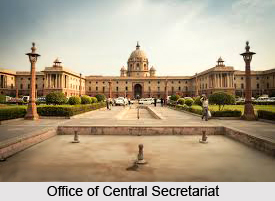 The Central Secretariat refers to the various offices and departments, which are run by the secretaries of the Union Government. The term "Secretariat" essentially means the Secretary"s office. Central Secretariat functions to increase coordination at the central level and to advise the minister in policy making and administrative matters. In order to enable him to discharge his functions properly, it is necessary that he should be equipped with an office. This office is the Central Secretariat. There are different types of government offices in the administrative structure of India, which vary in the nature and range of functions. At the top of all these offices is the Secretariat.
The Central Secretariat refers to the various offices and departments, which are run by the secretaries of the Union Government. The term "Secretariat" essentially means the Secretary"s office. Central Secretariat functions to increase coordination at the central level and to advise the minister in policy making and administrative matters. In order to enable him to discharge his functions properly, it is necessary that he should be equipped with an office. This office is the Central Secretariat. There are different types of government offices in the administrative structure of India, which vary in the nature and range of functions. At the top of all these offices is the Secretariat.
Reasons for the Presence of Central Secretariat
The Constitution of India has given the executive authority of the Union Government to the President of the country. All executive actions of the Union Government are taken in his name. However, the Indian President is a mere constitutional and formal head and there is a Council of Ministers with the Indian Prime Minister at its head to aid and advice the President in the exercise of his functions. The ministers cannot work all alone and need assistance. Therefore, the government of India is divided into ministries and departments, which together constitute the `Central Secretariat.` To implement the policies enunciated by the ministers in consultation with the Secretariat, there are attached offices, subordinate offices and other field agencies.
Central Secretariat as a Component of the Government
There are three essential components of the government at the centre. They are the minister, the secretary and the executive head. The most important function of the minister is to decide upon policy. The most important function of the secretary is to provide the material by which to reach such decisions and to oversee the implementation of such decisions. The executive head functions to carry out these decisions. The first two functionaries, namely, the minister and the secretary are served by the secretariat organization called a ministry or department. Orders and instructions issued by the secretariat are considered as orders of the Government of India. Thus, the Central Secretariat occupies a key position in the administrative hierarchy of the government. Under rules, each secretariat department is required to consult any other department that may be interested or concerned before disposing off a case.
Structure of Central Secretariat
The structure of the Central Secretariat relates to its internal hierarchy. At the lowest level, there is a section or the office, which has a Section Officer and a number of assistants, clerks, typists and peons. There are two sections, which make up a branch, for which an undersecretary is responsible. These two branches make up a division, which is lead by a deputy secretary. The Central Secretariat may have one or more wings. A joint secretary is responsible for each wing. The department is lead by the secretary himself or in some case by an additional or special secretary. Secretaries are secretaries of the Union Government as a whole and not of any particular minister.
Functions of Central Secretariat
The secretariat works as a single unit with collective responsibility, as in the case of the council of ministers. Central Secretariat functions to help the minister so that he can carry out his parliamentary functions and make policies. It is engaged in programme formulation, making rules and principles of procedure, budgeting and control of expenditure with respect to the activities of the ministry/ department, etc.
Central Secretariat Service
The Central Secretariat Service serves as the backbone of the administrative work and provides permanent bureaucracy and functionary staff in the Central Government of India. This service is governed by the Central Secretariat Service Rules of 1962, which has been issued under the powers of Article 309 of the Indian Constitution.
The 50 percent of the direct recruitment process between the years 1946 to 2003 was through the Civil Services Examination conducted by the Union Public Service Commission, while the next 25 percent was conducted through the Annual Department Examination and the rest was done by promotion. Currently, the mode of recruitment was changed to the grade of Section Officer by way of 50% through Limited Departmental Competitive Examination by Union Public Service Commission and 50% by seniority.






